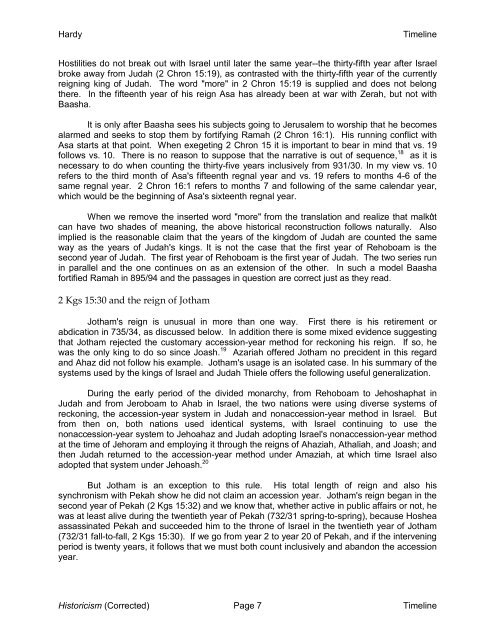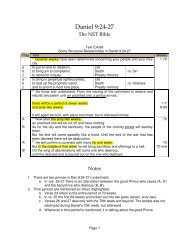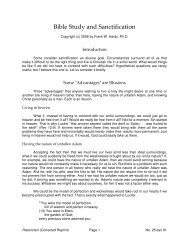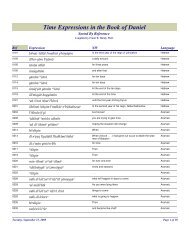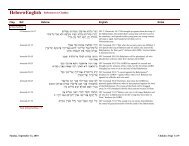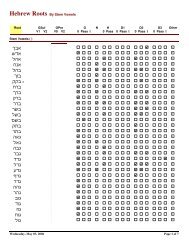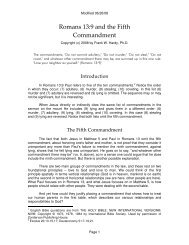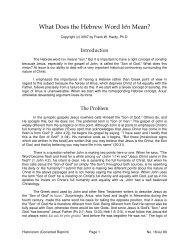A Timeline of the Kings of Israel and Judah - Historicism.org
A Timeline of the Kings of Israel and Judah - Historicism.org
A Timeline of the Kings of Israel and Judah - Historicism.org
Create successful ePaper yourself
Turn your PDF publications into a flip-book with our unique Google optimized e-Paper software.
Hardy<strong>Timeline</strong>Hostilities do not break out with <strong>Israel</strong> until later <strong>the</strong> same year--<strong>the</strong> thirty-fifth year after <strong>Israel</strong>broke away from <strong>Judah</strong> (2 Chron 15:19), as contrasted with <strong>the</strong> thirty-fifth year <strong>of</strong> <strong>the</strong> currentlyreigning king <strong>of</strong> <strong>Judah</strong>. The word "more" in 2 Chron 15:19 is supplied <strong>and</strong> does not belong<strong>the</strong>re. In <strong>the</strong> fifteenth year <strong>of</strong> his reign Asa has already been at war with Zerah, but not withBaasha.It is only after Baasha sees his subjects going to Jerusalem to worship that he becomesalarmed <strong>and</strong> seeks to stop <strong>the</strong>m by fortifying Ramah (2 Chron 16:1). His running conflict withAsa starts at that point. When exegeting 2 Chron 15 it is important to bear in mind that vs. 19follows vs. 10. There is no reason to suppose that <strong>the</strong> narrative is out <strong>of</strong> sequence, 18 as it isnecessary to do when counting <strong>the</strong> thirty-five years inclusively from 931/30. In my view vs. 10refers to <strong>the</strong> third month <strong>of</strong> Asa's fifteenth regnal year <strong>and</strong> vs. 19 refers to months 4-6 <strong>of</strong> <strong>the</strong>same regnal year. 2 Chron 16:1 refers to months 7 <strong>and</strong> following <strong>of</strong> <strong>the</strong> same calendar year,which would be <strong>the</strong> beginning <strong>of</strong> Asa's sixteenth regnal year.When we remove <strong>the</strong> inserted word "more" from <strong>the</strong> translation <strong>and</strong> realize that malku^tcan have two shades <strong>of</strong> meaning, <strong>the</strong> above historical reconstruction follows naturally. Alsoimplied is <strong>the</strong> reasonable claim that <strong>the</strong> years <strong>of</strong> <strong>the</strong> kingdom <strong>of</strong> <strong>Judah</strong> are counted <strong>the</strong> sameway as <strong>the</strong> years <strong>of</strong> <strong>Judah</strong>'s kings. It is not <strong>the</strong> case that <strong>the</strong> first year <strong>of</strong> Rehoboam is <strong>the</strong>second year <strong>of</strong> <strong>Judah</strong>. The first year <strong>of</strong> Rehoboam is <strong>the</strong> first year <strong>of</strong> <strong>Judah</strong>. The two series runin parallel <strong>and</strong> <strong>the</strong> one continues on as an extension <strong>of</strong> <strong>the</strong> o<strong>the</strong>r. In such a model Baashafortified Ramah in 895/94 <strong>and</strong> <strong>the</strong> passages in question are correct just as <strong>the</strong>y read.2 Kgs 15:30 <strong>and</strong> <strong>the</strong> reign <strong>of</strong> JothamJotham's reign is unusual in more than one way. First <strong>the</strong>re is his retirement orabdication in 735/34, as discussed below. In addition <strong>the</strong>re is some mixed evidence suggestingthat Jotham rejected <strong>the</strong> customary accession-year method for reckoning his reign. If so, hewas <strong>the</strong> only king to do so since Joash. 19 Azariah <strong>of</strong>fered Jotham no precident in this regard<strong>and</strong> Ahaz did not follow his example. Jotham's usage is an isolated case. In his summary <strong>of</strong> <strong>the</strong>systems used by <strong>the</strong> kings <strong>of</strong> <strong>Israel</strong> <strong>and</strong> <strong>Judah</strong> Thiele <strong>of</strong>fers <strong>the</strong> following useful generalization.During <strong>the</strong> early period <strong>of</strong> <strong>the</strong> divided monarchy, from Rehoboam to Jehoshaphat in<strong>Judah</strong> <strong>and</strong> from Jeroboam to Ahab in <strong>Israel</strong>, <strong>the</strong> two nations were using diverse systems <strong>of</strong>reckoning, <strong>the</strong> accession-year system in <strong>Judah</strong> <strong>and</strong> nonaccession-year method in <strong>Israel</strong>. Butfrom <strong>the</strong>n on, both nations used identical systems, with <strong>Israel</strong> continuing to use <strong>the</strong>nonaccession-year system to Jehoahaz <strong>and</strong> <strong>Judah</strong> adopting <strong>Israel</strong>'s nonaccession-year methodat <strong>the</strong> time <strong>of</strong> Jehoram <strong>and</strong> employing it through <strong>the</strong> reigns <strong>of</strong> Ahaziah, Athaliah, <strong>and</strong> Joash; <strong>and</strong><strong>the</strong>n <strong>Judah</strong> returned to <strong>the</strong> accession-year method under Amaziah, at which time <strong>Israel</strong> alsoadopted that system under Jehoash. 20But Jotham is an exception to this rule. His total length <strong>of</strong> reign <strong>and</strong> also hissynchronism with Pekah show he did not claim an accession year. Jotham's reign began in <strong>the</strong>second year <strong>of</strong> Pekah (2 Kgs 15:32) <strong>and</strong> we know that, whe<strong>the</strong>r active in public affairs or not, hewas at least alive during <strong>the</strong> twentieth year <strong>of</strong> Pekah (732/31 spring-to-spring), because Hosheaassassinated Pekah <strong>and</strong> succeeded him to <strong>the</strong> throne <strong>of</strong> <strong>Israel</strong> in <strong>the</strong> twentieth year <strong>of</strong> Jotham(732/31 fall-to-fall, 2 Kgs 15:30). If we go from year 2 to year 20 <strong>of</strong> Pekah, <strong>and</strong> if <strong>the</strong> interveningperiod is twenty years, it follows that we must both count inclusively <strong>and</strong> ab<strong>and</strong>on <strong>the</strong> accessionyear.<strong>Historicism</strong> (Corrected) Page 7 <strong>Timeline</strong>


